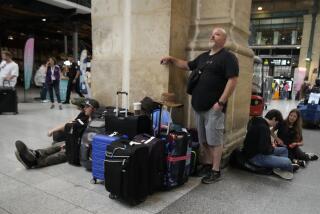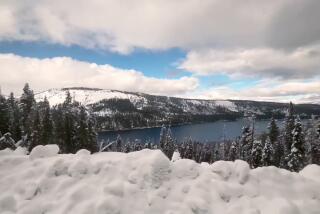Trying to Stay Up to Speed on Some Fast Tracks
- Share via
I recently traveled with a fast crowd in France, as fast as 186 m.p.h.
We were the passengers on the TGV Atlantique, a high-speed train of silver and blue that spurts from Paris’ Montparnasse station to Rennes, the gateway to Brittany.
We were mostly French, English and American. We were tourists and commuters.
Our travel time? Two hours and four minutes. It used to take twice as long. What was a weekend outing now can be a day-trip.
This is the first year of such service to the west by the French TGV (Trains a Grande Vitesse), the fastest trains in the world. Frankly, I had some doubts about the journey.
To begin with, I was not happy about riding backwards, the position of at least half the seats, including the one that I was assigned. The conductor insisted that I would be comfortable; he also said the train was sold out.
“You have no idea how prone I am to motion sickness,” I muttered to myself as the train began to glide. The first time I rode an elevator to the top of New York City’s World Trade Center, I had to take a seasick pill.
The conductor turned out to be right. Once I stopped counting blurred telephones poles, I felt at ease with my direction.
There is no nostalgic clickety-clack with the high-speed trains, which seems a little sad. There is no moment when you lapse into the storybook rhythm of “I think I can, I think I can.”
The steady, even ride is computer-controlled from Paris. Uphill is as smooth as down. Curves are less sharp than on standard trains. The driver’s main function is to be alert and brake if needed. He cannot increase the speed.
The TGVs have their own rails, and the plan is to slow for nothing. Highways go over or under the tracks. Every 12 miles there are underpasses for wildlife, a move forced by environmentalists so that animals could get to their traditional watering holes. A protective wire fence borders the entire route.
The only physical problem I had was in the first few miles out of Paris. There are several tunnels, and my ears clogged with pressure each time. Yawning was the solution. Snacking also helped.
I stared from big picture windows at the French countryside, at the rows of Lombardy poplars and the crab apple trees in bloom.
Black-and-white cows munched nearby. Church spires graced the horizon. On a lane parallel to our track, a farmer in black vest and pants was driving a red tractor.
Whoosh and he was gone . . . or we were.
The ride was so smooth that the woman across the aisle was writing poetry and staying within the lines. I peeked over her shoulder when I walked to the restroom.
Many travelers read newspapers. Some played cards. I saw no coffee spilled, nor any Cognac or wine.
After a full day at Mont-St. Michel, on the border of Brittany and Normandy, we headed back from Rennes to Paris. There was still daylight at 7 p.m. A sudden rain squall sounded like hail on the metal-skinned TGV.
About 40 miles outside Paris, I looked toward the highway. Traffic seemed gridlocked. I was glad to be riding a train.
Then it was twilight. We passed a modern rail yard where other silver-and-blue Atlantique trains were parked for the night. They reminded me of sleek spaceships, and I smiled at the memory of a conversation with astronaut Wally Schirra.
Only two days earlier, we had been on the same plane from San Diego to New York City. He was going to a board meeting in Manhattan. I said I was going on to Paris.
“Wow,” the former astronaut said earnestly. “That’s a long flight.”
He should know.
More to Read
Sign up for The Wild
We’ll help you find the best places to hike, bike and run, as well as the perfect silent spots for meditation and yoga.
You may occasionally receive promotional content from the Los Angeles Times.






